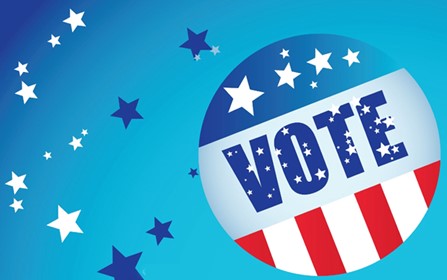(We Chinese in America Media Editor Tang Zhao, March 25, 2022) Per County of San Diego Communications Office, You don’t have to wait until Election Day to vote in person. Voters eligible to vote in the April 5 Special Primary Election for Assembly District 80 can take advantage of early voting at five vote centers starting Saturday, March 26. The centers will be open from 8 a.m. to 5 p.m. through Monday, April 4 at the locations below:
- Southwestern Community College
- Lot A, Building 18A-Room 214
- 900 Otay Lakes Road
- Chula Vista, 91910
- Camacho Recreation Center
- Gym
- 1810 E. 22ndStreet
- National City, 91950
- Southcrest Recreation Center
- Meeting Room 1
- 4149 Newton Ave.
- San Diego, 92113
- Montgomery High School
- Library
- 3250 Palm Ave.
- San Diego, 92154
- Colonel Irving Salomon Community Center
- Game Room
- 179 Diza Road
- San Diego, 92154
On Election Day, April 5, four more vote centers will open for a total of nine locations and the hours will change to 7 a.m. to 8 p.m. You can find a vote center or ballot drop box location near you inside your voter information pamphlet. Or you can look it up online at sdvote.com.
Vote centers replace polling places and provide more services. You can visit any one of the County’s vote centers to drop off your ballot or vote in person. Vote center services include:
- ADA accessible ballot marking devices
- Voting assistance in the County’s four federally covered languages: Spanish, Filipino, Vietnamese and Chinese
- Voter registration or updates, and voting on the same day
- Voting in person if you made a mistake or lost your mail ballot
Voters will use a touch screen to make their selections on ballot marking devices. When finished, the voter will print out a paper official ballot with their selections. The voter can review the ballot and place it in the ballot box to be counted at the Registrar’s office. The ballot marking device does not store, tabulate or count any votes.
Remember that campaigning or electioneering within 100 feet of a vote center or ballot drop box location is not allowed. This includes the visible display or audible dissemination of information that advocates for or against any candidate on the ballot.
Voters can still save themselves the trip and mark their ballot from home. Be sure to sign and date the return envelope, seal your completed ballot inside and return it to a ballot drop box location or vote center.
Early voting is already underway at the Registrar’s office from 8 a.m. to 5 p.m. Monday through Friday. Some ballot drop box locations and the Registrar of Voters office will be closed on Thursday, March 31 in observance of Cesar Chavez Day.
If you already returned your mail ballot, you can confirm when it was received by the Registrar’s office at sdvote.com or you can track it through the U.S. Postal Service by signing up for “Where’s My Ballot?”.
Learn more about voting in the 80th Assembly District Special Primary Election at sdvote.com, call (858) 565-5800 or toll free at (800) 696-0136.
(Source & Photo: County of San Diego Communications Office)
This website has a free subscription function, please enter your email address and name (any nickname) in the upper right corner of the page. After subscribing, you can receive timely updates of the website. I hope that new and old readers will actively subscribe, so that we have the opportunity to provide you with better services
Please click: Home (wechineseus.com) for more news and content on this website
Follow The Chinese Media's Twitter account: https://twitter.com/wechineseinus
Follow The Chinese Media's Facebook account: https://www.facebook.com/wechineseinamerica/
【We Chinese in America Media Editor Tang Zhao, March 25, 2022】 The report notes that wealthy Chinese families still value Western education, but most want their children to return to China after completing their overseas studies. (Photo from China News Weekly)
Hurun Research Institute and Qingmiao Education Group recently jointly released the "2021 China International Education White Paper". The report randomly interviewed more than 600 respondents with family assets of more than 10 million yuan (about 1.57 million US dollars) and found that these wealthy Families still value a Western education, but most want their children to return to China after they finish their studies abroad.

The picture shows Chinese parents accompany their students to the education exhibition. (Getty Images)
According to the Observer.com report, the respondents mainly include two types of groups: one is the parent group whose children are or plan to receive international education, and the other is the parent group who has an international education experience. The average age of the respondents is 36 years old, and the average family assets are 34 million yuan (about 5.33 million US dollars). 49% are from first-tier cities in China, and 51% are from second- and third-tier cities, mainly middle-level executives, and corporate executives.
The report pointed out that many Chinese parents want their children to return to China after studying abroad, and they believe that China has a brighter future.
According to data released by the Ministry of Education of China, the total number of Chinese students studying abroad in 2019 was 700,000, an annual increase of 6.3%, and the number of returnees from studying abroad was 580,000, an annual increase of 12%. Among those with international education experience, more than 90% plan to return to China or have already started their careers in China.

(Photo from the Observer Network)
The reason is that China's domestic economic development is relatively good which is the primary reason for returning to China for development, with a 59% response ratio; China's domestic entrepreneurial environment is good (with a 56% response ration) ; it is convenient to reunite with family and friends (with a response ratio of 52%), while The attraction of China's domestic talent policy (with a response ration of 51%) is also an important reason why more than half of the international students choose to return to China for opportunities.
Chu Zhaohui, a senior researcher at the Chinese Academy of Educational Sciences, believes that (Chinese) parents certainly want their children to be better at independent thinking and open-minded, which is what their generation lacks. The idea of Chinese parents wanting their children to return to China is also rooted in traditional Social Values.
The report pointed out that the four traditional study abroad countries of the United States, Britain, Canada, and Australia are still popular, and other European are also in the selection range, showing a diversified trend of studying abroad. With the increasing number of Sino-foreign cooperative education programs, choosing an international school in China has become a new trend.
From the perspective of the content and form of international education, the integration of Chinese and Western will be the main trend in the future. Specifically, Chinese, and Western integration includes the integration of Chinese and Western cultures, courses, teachers, and teaching methods.
(Source: World News Network)
This website has a free subscription function, please enter your email address and name (any nickname) in the upper right corner of the page. After subscribing, you can receive timely updates of the website. I hope that new and old readers will actively subscribe, so that we have the opportunity to provide you with better services
Please click: Home (wechineseus.com) for more news and content on this website
Follow The Chinese Media's Twitter account: https://twitter.com/wechineseinus
Follow The Chinese Media's Facebook account: https://www.facebook.com/wechineseinamerica/
【We Chinese in America Media Editor Tang Zhao, March 23, 2022】
Here is this week’s COVID-19 update from the County Health and Human Services Agency with data through March 22, 2022.
Vaccination Progress:
- Received at least one shot: Close to 2.95 million or 93.7% of San Diegans age 5 and older are at least partially vaccinated.
- Fully vaccinated: More than 2.59 million or 82.3%.
- Boosters administered: 1,205,205 or 55.5% of 2,171,477 eligible San Diegans.
- More vaccination information can be found at coronavirus-sd.com/vaccine.
Deaths:
- 13 new deaths were reported since the last report on March 16, 2022. The region’s total is 5,146.
- Eight women and five men died between Jan. 21, 2022 and March 19, 2022.
- Six were age 80 or older, four were in their 70s and three were in their 60s.
- Four of the people who died were fully vaccinated and nine were not fully vaccinated.
- 11 had underlying medical conditions and two had medical history pending.
Cases, Case Rates, Hospitalizations and Testing:
- 304 COVID-19 cases were reported to the County on March 22, 2022. The region’s total is now 748,407.
- 2,774 cases were reported in the past week (March 16 through March 22) compared to 2,987 infections identified the previous week (March 9 through March 15).
- San Diego County’s case rate per 100,000 residents 12 years of age and older is 8.6 for people fully vaccinated and boosted, 7.8 for fully vaccinated people and 19.9 for not fully vaccinated San Diegans.
- 6,037 tests were reported to the County on March 20, 2022, and the percentage of new positive cases was 2.8%.
- The 14-day rolling percentage of positive cases among tests reported through March 20, 2022 is 3.4%.
More Information:
Data updates to the County’s coronavirus-sd.com website are published Monday through Friday around 5 p.m., with the exception of holidays.
(Source: County of San Diego Communications Office)
This website has a free subscription function, please enter your email address and name (any nickname) in the upper right corner of the page. After subscribing, you can receive timely updates of the website. I hope that new and old readers will actively subscribe, so that we have the opportunity to provide you with better services
Please click: Home (wechineseus.com) for more news and content on this website
Follow The Chinese Media's Twitter account: https://twitter.com/wechineseinus
Follow The Chinese Media's Facebook account: https://www.facebook.com/wechineseinamerica/
(We Chinese in America Media Editor Tang Zhao, March 24, 2022) Following a decade of petitions by the late Yuan Ai Recreation Center chairman Alfred Yin and City Farmer's Market Vietnamese director Ben Vo, the Georgia Department of Agriculture announced last week that starting today, with a permit, Water spinach (aka Ipomoea wateraca) could be legally sold in Georgia. (Photo from website)
The Department of Agriculture pointed out that water spinach is commonly eaten in many parts of the world, especially in Asia. But because water spinach is highly invasive, it is regulated by the U.S. Department of Agriculture (USDA) and many states. However, in California, Florida, Hawaii, and Texas, it is legal to sell or grow it as long as you have a license.
Wooiyi Yin, the widow of Yin Maoda and the current chairman of Yuanai Recreation Center, said that water spinach is the favorite vegetable of many Asians, but because the plant can easily grow everywhere in water, it has been banned by Georgia regulations for many years. (Photo from website)
Although the law does not allow planting and selling, in fact, private planting or trading has existed for many years. Not only does the government lose sales tax revenue because of this, but private trading is not regulated, and people’s rights and food safety are also exposed to great risks.
In 2012, Yin Maoda and Ben Vo collected about 500 signatures and filed a petition with state senator Pete Marin, hoping to amend the law to allow water spinach to be sold and grown legally. After years of hard work and the efforts of many Asian-American parliamentarians and groups, the sale of water spinach has finally been made legal.

(Raw Water Spinach-Photo from website)
Georgia Department of Agriculture Secretary Gary W. Black said the department approved water spinach for sale in Georgia after reviewing the Department of Agriculture and Texas' pest risk analysis and sharing communications with other states. He encouraged shops and restaurants to buy water spinach from vendors with a PPQ-526 license from the Department of Agriculture.

(Stir Fried Water Spinach with Fermented Tofu Photo from The Woks of Life)
To date, the USDA has approved three permits to sell water spinach in Georgia, and more are expected to be issued.
Marvin Lim, a Filipino Georgia State Assemblyman who helped push the case, said his district, Gwinnett, has the highest percentage of Asians in Georgia, especially Southeast Asians. The legalization of the water spinach sale demonstrates the importance of Georgia’s provision of food that is relevant to Asian multiculturalism and benefits the Asian community.
According to the Florida Fish and Wildlife Conservation Commission website, because hydroponic water spinach grows so quickly and creates highly entangled vegetation that obstructs drainage and water flow, it may replace the Native plants important to fish and aquatic animals and plants. According to Florida law, water spinach can only be cultivated under the supervision of the state's Department of Agriculture and Consumer.
Chen Huiyi said that under the supervision of laws and regulations, the soil cultivation method should be able to solve the problem of water spinach invading waters. Currently, water spinach is not allowed in Georgia. However, officials at the Department of Agriculture say regulations are being developed to legally grow water spinach, which is expected to be announced later this year.
(Source: Compiled from Online Information)
This website has a free subscription function, please enter your email address and name (any nickname) in the upper right corner of the page. After subscribing, you can receive timely updates of the website. I hope that new and old readers will actively subscribe, so that we have the opportunity to provide you with better services
Please click: Home (wechineseus.com) for more news and content on this website
Follow The Chinese Media's Twitter account: https://twitter.com/wechineseinus
Follow The Chinese Media's Facebook account: https://www.facebook.com/wechineseinamerica/
(We Chinese in America Media Editor Tang Zhao, March 23, 2022) The County Health and Human Services Agency is reporting 96 lab-confirmed influenza cases in the region for the week, up from 60 the previous week.
This season’s total now stands at 1,818 flu cases, compared to 733 infections identified at the same time last year. In comparison, the prior five-year average was 10,651 cases by the same week.
“While we’re not seeing influenza case counts as high as in many previous seasons, San Diegans should continue getting vaccinated,” said Wilma J. Wooten, M.D., M.P.H., County public health officer. “The flu vaccine is the best protection we have to protect ourselves and others from getting sick.”
The latest Influenza Watch Report from the County Health and Human Services Agency shows the following for the week ending March 19, 2022:
- Emergency department visits for influenza-like illness: 3% of all visits (compared with 2% the previous week).
- Lab-confirmed influenza cases for the week: 96 (compared to 60 the previous week).
- Total lab-confirmed cases to date: 1,818 (compared to 733 at the same time last season and a 10,651 prior 5-year average during the same week).
- Influenza-related deaths reported to date: 4 (compared to 2 at the same time last year).
How to Prevent the Flu
The Centers for Disease Control and Prevention (CDC) recommends that everyone 6 months and older get a flu shot every year. It takes about two weeks for immunity to develop. The CDC also indicates you can get a flu and COVID-19 vaccination at the same time, including a booster dose. The coronavirus vaccine does not work against influenza and vice versa.
The flu vaccine is especially important for people at higher risk of having serious complications from the virus.
They include:
- People with chronic medical conditions like asthma, diabetes, and lung disease, even if symptoms are under control
- Pregnant women
- People aged 65 years and older
- People who live with or care for others who are at higher risk
The influenza vaccine is available at doctors’ offices and retail pharmacies and is covered by medical insurance. People with no health care coverage can get vaccinated at one of the County’s six public health centers or a local community clinic. To find the nearest location, visit the County’s Flu Vaccine Locations page or call 2-1-1 San Diego.
In addition to getting vaccinated, people should also do the following to avoid getting sick:
- Wash hands thoroughly and often;
- Use hand sanitizers, if unable to wash hands;
- Stay away from sick people;
- Avoid touching your eyes, nose, and mouth;
- Clean commonly touched surfaces; and
- If you are sick, stay home and avoid contact with others.
During the 2020-2021 flu season, a total of 848 influenza cases were reported in San Diego, including two deaths. During the 2019-2020 flu season, more than 20,700 flu cases were reported and 108 San Diegans died from influenza.
(Source: County of San Diego Communications Office)
This website has a free subscription function, please enter your email address and name (any nickname) in the upper right corner of the page. After subscribing, you can receive timely updates of the website. I hope that new and old readers will actively subscribe, so that we have the opportunity to provide you with better services
Please click: Home (wechineseus.com) for more news and content on this website
Follow The Chinese Media's Twitter account: https://twitter.com/wechineseinus
Follow The Chinese Media's Facebook account: https://www.facebook.com/wechineseinamerica/















